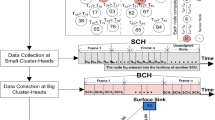Abstract
In the real application situations, the wireless sensor networks (WSNs) usually consist of a large number of sensor nodes with limited energy to monitor the environment. The energy efficiency is one of the most important challenges for WSNs in order to extend the network lifetime. There are several widely-used methods to achieve this goal, such as data fusion at coordination sensor nodes, and turning off redundant nodes, etc. The existing methods of redundant nodes elimination are analyzed, and their disadvantages are discussed. Then a new method of redundant node elimination based on the coverage probability is proposed to maximize the network lifetime for the heterogeneous WSNs. Combining with EECRS protocol, an energy efficient protocol based on redundant nodes elimination is proposed. Using random sensors deployment with different sensing radii, it is shown that the sensing coverage quality after using proposed redundant nodes determination method can be guaranteed to 99.9% with more than 8 neighbor nodes for each sensor node, and proposed method has less on-duty nodes compared with other methods. And that can reduce the energy consumption of network. Compared with perimeter coverage protocol and CCP protocol, proposed protocol can extend the network lifetime.
Access this chapter
Tax calculation will be finalised at checkout
Purchases are for personal use only
Preview
Unable to display preview. Download preview PDF.
Similar content being viewed by others
References
Kulkarni, R.V., Forster, A., Venayagamoorthy, G.K.: Computational Intelligence in Wireless Sensor Networks: a Survey. IEEE Communications Survey & Tutorials 13(1), 68–96 (2011)
Zhu, C., Zheng, C.L., Shu, L., et al.: A Survey on Coverage and Connectivity Issues in Wireless Sensor Networks. Journal of Network and Computer Applications 35(2), 619–632 (2012)
Yuea, J., Zhang, W.M., Xiao, W.D., et al.: Energy Efficient and Balanced Cluster-Based Data Aggregation Algorithm for Wireless Sensor Networks. Procedia Engineering, 2009–2015 (2012)
Zungeru, A.M., Ang, L.M., Seng, K.P.: Classical and Swarm Intelligence Based Routing Protocols for Wireless Sensor Networks: a Survey and Comparison. Journal of Network and Computer Applications 35(5), 1508–1536 (2012)
Francesco, M.D., Das, S.K., Anastasi, G.: Data Collection in Wireless Sensor Networks with Mobile Elements: a Survey. ACM Transactions on Sensor Networks 8(1), 1–31 (2011)
Xing, G.L., Wang, X.R., Zhang, Y.F.: Integrated Coverage and Connectivity Configuration for Energy Conservation in Sensor Networks. ACM Trans. Sensor Networks 1(1), 36–72 (2005)
Huang, C.F., Tseng, Y.C.: The Coverage Problem in a Wireless Sensor Network. Mobile Networks and Applications 10(4), 519–528 (2005)
Megerian, S., Koushanfar, F., Potkonjak, M., et al.: Worst and Best-Case Coverage in Sensor Networks. IEEE Transaction on Mobile Computing 4(1), 84–92 (2004)
Tian, D., Georganas, N.D.: A Coverage-preserving Node Scheduling Scheme for Large Wireless Sensor Networks. In: WSNA 2002 Proceedings of the 1st ACM International Workshop on Wireless Sensor Networks and Applications, pp. 32–41. ACM Press, Atlanta (2002)
Heinzelman, W.B., Chandrakasan, A.P., Balakrishnan, H.: An Application-Specific Protocol Architecture for Wireless Microsensor Networks. IEEE Transactions on Wireless Communications 1(4), 660–670 (2002)
Younis, O., Fahmy, S.: HEED: a Hybrid, Energy-efficient, Distributed Clustering Approach for Ad Hoc Sensor Networks. IEEE Transactions on Mobile Computing 3(4), 366–379 (2004)
Vaidehi, V., Selvan, U.S., Jayendran, J., et al.: Redundant Node Deactivation by Scheduling in Wireless Sensor Networks. In: 2011 International Conference on Recent Trends in Information Technology (ICRTIT), pp. 613–617. Curran Associates, Chennai (2011)
Huang, S.Z., Zhao, X.Z.: An Energy-Efficient Cluster Head and Router Selecting Protocol for Wireless Sensor Networks. Applied Mechanics and Materials 226-228, 1807–1810 (2012)
Author information
Authors and Affiliations
Editor information
Editors and Affiliations
Rights and permissions
Copyright information
© 2013 Springer-Verlag Berlin Heidelberg
About this paper
Cite this paper
Huang, S., Zhao, X. (2013). Redundant Nodes Elimination in Wireless Sensor Networks. In: Yang, Y., Ma, M., Liu, B. (eds) Information Computing and Applications. ICICA 2013. Communications in Computer and Information Science, vol 391. Springer, Berlin, Heidelberg. https://doi.org/10.1007/978-3-642-53932-9_5
Download citation
DOI: https://doi.org/10.1007/978-3-642-53932-9_5
Publisher Name: Springer, Berlin, Heidelberg
Print ISBN: 978-3-642-53931-2
Online ISBN: 978-3-642-53932-9
eBook Packages: Computer ScienceComputer Science (R0)




